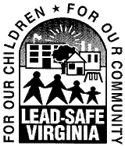 Childhood lead poisoning is considered the most preventable environmental disease among young children. Houses or childcare centers built before 1978 may have lead-based paint on walls, doors, windows, and sills. The primary source of exposure to children is through the dust from deteriorating lead-based paint. Use only certified lead workers for any renovation, repairs, or painting!
Childhood lead poisoning is considered the most preventable environmental disease among young children. Houses or childcare centers built before 1978 may have lead-based paint on walls, doors, windows, and sills. The primary source of exposure to children is through the dust from deteriorating lead-based paint. Use only certified lead workers for any renovation, repairs, or painting!
Lead in drinking water is a potential source of exposure for formula fed infants and fetuses. Have your water tested, use certified lead-free bottled water, or an NSF approved filter. www.nsf.org
- Information about Lead in Drinking Water: What You Can Do
- World Health Organization (WHO) LEAD FACT SHEET
- Governor's Proclamation
Protecting children from exposure to lead is important to lifelong good health. There is no safe blood lead level, and even low levels of lead in blood can potentially affect IQ, ability to pay attention, and academic achievement. The effects of lead exposure cannot be reversed.
Prevent lead poisoning. Get your home tested. Get your child tested. Get the facts!
The goal is to prevent lead exposure to children before they are harmed. There are many ways parents can reduce a child’s exposure to lead. The most important is stopping children from coming into contact with lead. Lead hazards in a child’s environment must be identified and controlled or removed safely. Please ask your provider to test your child at age one and two years of age.
- CDC Guidelines for Collecting and Handling Blood Lead Samples
- Potential for Falsely Low Blood Lead Test Results from LeadCare® Analyzers
 Consumer Product Safety Commission Improvement Act
Consumer Product Safety Commission Improvement Act
Many parents are concerned about the safety of children’s toys and products. Due to a spike in national recalls for toys containing high levels of lead during 2008, federal legislation was passed that limits the amount of lead in toys and products for children 12 years of age and under.
To help you stay informed of the latest product recalls, visit the U.S. Consumer Product Safety Commission.
To read more about the Consumer Product Safety Commission Improvement Act (CPSCIA), go to Consumer Product Safety Improvement Act.
Folk Medicines: https://www.cdc.gov/nceh/lead/tips/folkmedicine.htm
Mexican Candy: https://www.cdc.gov/nceh/lead/tips/candy.htm
Toys: https://www.cdc.gov/nceh/lead/tips/toys.htm
Toy Jewelry: https://www.cdc.gov/nceh/lead/tips/jewelry.htm
Childhood lead poisoning is considered the most preventable environmental disease among young children. The Childhood Lead Poisoning Prevention Program (CLPPP) within VDH's Division of Surveillance and Investigation at VDH's Central Office is a CDC-funded program. The program provides:
- Surveillance and analysis of reported blood lead levels in children less than 16 years of age
- Education and outreach to parents, communities, and health professionals about childhood lead poisoning and prevention, and
- Oversight to providers and local health department staff on screening, testing, and case management for children exposed to lead
The CLPPP aims to ensure that children at risk for lead exposure are identified, tested, and connected to additional services. Through collaboration with local health department staff, health care providers, environmental health specialists, and public health partners, the VA CLPPP aims to make our state a Lead Safe Virginia.
Information about Lead in the Home
Click here to find information about sources of lead and preventing lead exposure, legal considerations for real estate and rental properties, and information for lead professionals.
Information for Parents
Click here to find information about how to keep your family safe from lead exposure and learn what to do if your child has been exposed to lead.
Information about Adult Lead Poisoning
Click here to learn about sources of lead exposure for adults (at work and from hobbies), and how you can prevent bringing lead home to your family.
Information for Health Care Providers
Click here to find information about screening and reporting guidelines, training and continuing education opportunities, materials for patients.
Information for Childcare Centers
Click here for information about potential sources of lead, health effects for children, tips for keeping your facility lead-free, and educational resources for staff.
For more information:
Ashley Koski, Program Coordinator
ashley.koski@vdh.virginia.gov
804-929-6736
Janine Kerr, Health Educator
janine.kerr@vdh.virginia.gov
804-929-5099
Andrew Tran, Toxic Substances Epidemiologist
andrew.tran@vdh.virginia.gov
804-864-8093
